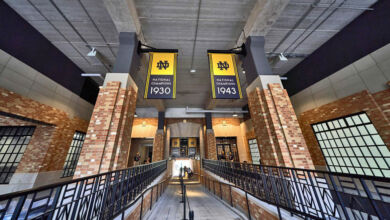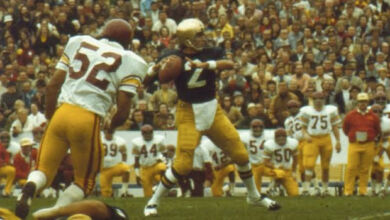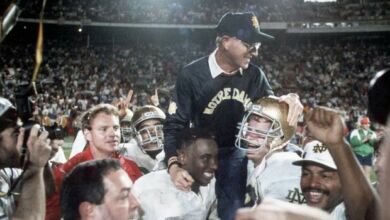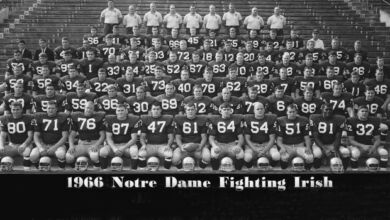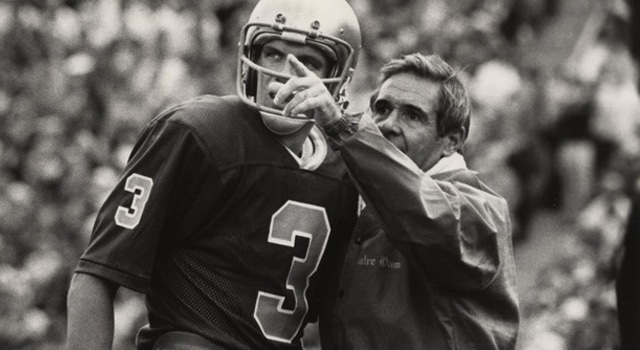
“All animals are equal but some are more equal than others.” George Orwell, Animal Farm
Well at Notre Dame, all national championships are different but some are more different than others.
Dan Devine
Notre Dame’s most under-appreciated coach, but a fine one. Al McGuire used to talk about the futility of following a legend, and posited that the UCLA coaches who followed the nonpareil John Wooden would struggle, not with X’s and O’s but with nostalgic fans and the leadership vacuum. But Devine, as tough as nails, was not daunted by following Ara.
And there’s one thing to remember about Devine. Ara has famously stated “I had 13 years of head coaching experience before I took the job at Notre Dame and I needed every one of those to succeed. When Notre Dame’s hubris violated Ara’s edict in the Faust, Davie and Weis hires, the chickens came home to roost. Devine, in addition to his Packer stint, had coached for 2 years at ASU and 13 at Missouri. He had also been an assistant under Biggie Munn at MSU.
Dan was a field coach, and he gave lousy podium. The emotionally needy Notre Dame fan community, which hung on every golden phrase and affirmation from Ara, never really adjusted to the taciturn, poker-faced Devine, who regarded each minute talking to the press as a minute less available to coach his Irish.
1976’s Luke Warm End
1976 was thought to be promising, but Tony Dorsett with 160 yards rushing and the soon to be National Champion Pitt Panthers destroyed the Irish and quarterback Rick slager, 31-10, in the opener. The Irish had won their bowl game, 20-9 over Penn State in the Gator Bowl but it came after the usual regular season-ending loss to SC in the Coliseum 17-13.
Can I get a quarterback?
Devine coached in a manner that made it seem that the qb position was the 22d one he and his staff got around to deciding.
Joe Montana had showed some flashes as a soph in 1975 but struggled once elevated to starter, and Montana was plagued by injuries in 1976. Rick Slager may have been the answer, but only to the question what Notre Dame quareterback is better at tennis than football?. Rawboned Rusty Lisch showed promise, and former prep phenom Gary Forystek, who was from the Detroit area, was in the mix.
The defense looked solid. Ross Browner and Willie Fry were the active, aggressive battle-tested defensive endx. They were perfectly complemented by tackles Ken Dike and MiKe Calthoun. Neither tackle was an NFL prospect, but they “stayed home” and cleaned up the fragments from the destruction wrought by Browner Fry and NG/NT Bob Golic, a rambunctious marauder in the middle whether upright or with his hand on the ground.
Steve Heimkreiter and Doug Becker were ruthless tacklers at the outside linebacking positions.
Luther Bradley was on his way to All America honors and had moved to cornerback alongside fiery Ted Burgmeier. Joe Restic, son of the Harvard coach was one safety and was joined by lil’ brother Jim Browner.
It is arguable that Notre dame has never had a coach any better at assembling a staff of assistant coaches than Dan Devine. Devine’s staff included the great jim Johnson, on his way to stardom as defensive coordinator for And Reid’s Eagels, Merv Johnson, Joe Yonto, George Kelly and Francis Peay.
Notre Dame’s Slow September
The 1977 Irish did not exactly thunder out of the gate. The opener was against defending National Champion, but now Dorsett-less Pitt, right there where the Allegheny meets the Monongahela. A bonus for ND fans was that Ara Parseghian was the color man on the telecast. Pitt had a fine quarterback, Matt Cavanaugh, and early inthe game DE Willie Fry tackled Cavanaugh and drove him to the ground, dislocating a shoulder. In Ara’s high pitched professorial voice he offered “If you can’t execute the fundamental of the center snap to the quarterback, you have difficulty executing your offense.” Pitt would fumble four snaps from the center to the substitue quarterback. In the final three stanzas, Pitt generated 4 first downs, 7 turnovers and 6 yards of total offense. The Irish were never out of control of the game after Cavanaugh went down, but Lisch was struggling and the offense had the first-game blues.
The Irish won 19-9, but it was neither pretty nor encouraging.
The Irish next traveled to an unfamiliar venue, the State of Mississippi and played Ole Miss in “neutral” Jackson, Mississippi rather than in Oxford. The Irish offense was dreadful, and the players seemed to wilt in the sultry heat of a Mississippi September.
The Irish were in the game in the 4th quarter, but succumbed to Ken Cooper’s rebels, 20-13. The Irish offense saw its last two drives end in a fumble by Jerome Heavens and then an interception by Lisch. The Irish were now a desultory 1-1 and there was much rumbling and grumbling.
The Irish next headed to Purdue and their new phenom quarterback, Dave Herrmann. Purdue’s new coach, Dave Young, had his Boilers ready and Purdue led in the third quarter 24-14.
Let’s just pause here. The 1-1 Irish trailed Purdue by 10 points in Ross-Ade deep into the third quarter. Now if you, at that point were confident that the Irish would finish the season as National Champs, raise your hand. Liar!!
Lisch had struggled, and was replaced by the every popular second string quarterback, the vaunted Gary Forystek, but he swiftly suffered a year ending injury. It looked bleak for the IRISH.
BUT THIS IS WHY YOU KEEP PLAYING, WHAT THOUGH THE ODDS BE GREAT OR SMALL. Devine resorted to third string quarterback Joe Montana and somewhere, a light bulb went on. Montana, evocative of his stirring, but unrepeated, comebacks of 1975, rallied the Irish to a 31-24 victory, with lots of Montana magic including the go ahead TD pass of 13 yards to Ken MacAfee.
The Irish returned home for a tussle with Darryl Rogers; Michigan State Spartans, never an easy foe for the Irish. The Spartans were spirited, but the Irish maintained control, winjning 16-6 for a 3-1 record.
Merv Johnson’s offense was starting to show signs. The offensive line of Tim Foley, Ted Horansky, Dave Huffman, Ernie Hughes and Steve McDaniel were pushing people around. Montana had Jerome Heavens and Vagas Ferguson to hand off to, Dave Waymer lurking at wingback/flanker, with All-American player and boy Ken MacAfee at tight end, complemented by Kris Haines at wideout.
October Surprise
The Irish next had a week off. Good coaches improve their teams throughout the season. Good coaches can reengineer and revivify their teams during an open week. But this time, a truly different team would emerge from the break.
The Irish were goint to play Army in the gleaming new Meadowlands Stadium in Jersey. Two things shocked Irish fans that day.
First, Notre Dame’s traditionalists were prepared to despise the modernity and symmmetry, and thereby, the soullessness of the Meadowlands Stadium. But the sight lines were amazing, and there was not a bad seat in the house. The key was that the lower stands were elevated, about 10 feet higher than the field. The second key design factor
was the steep banking of the seats. Years later, many stadia would be remodeled to drop the field then steepen the banking, thereby enhancing the sight lines.
The second shock was the crispness of the Irish performance against Army. The score was a “mere” 24-0 but it was effortless. The Irish were machine-like, both offensively and defensively. It hardly seemed like the same team that had played Pitt, Ole Miss, Purdue and Michigan State. That was the good news. The bad news was the identity of next week’s visitor:: Southern Cal. The Irish had just Ara’s ’73 win over SC in the last DECADE!
Notre Dame’s Green Jerseys
Knute Rockne had created football’s greatest motivational tool in the timeless “Win One for the Gipper” speech.
“The greatest victory is that which requires no battle” Sun Tzu
And Devine may have created the runner up for football’s greatest motivational tool.
As the campus and the alumni girded their loins for battle with the Trojans, Devine was at his X’s and O’s and maintaining the upward climb his team had been on since early October.
Notre Dame had been using blue home jerseys since Parseghian’s arrival in 1964. But Devine ordered green jerseys for his team in August, keeping their availabiltiy a closely guarded secret.
October 22, 1977 was overcast, and only Devine’s four captains and the managers knew what was up. The team came out to the SC-nervous Irish crowd and warmed up in the familiar blue jerseys. While they were warming up the managers were distributing the green jerseys to the players lockers. Poker-faced Devine gave no clues.
Then the warmups concluded and when the players went back in and saw the green game jerseys they erupted and adrenaline flowed like living water. Now let’s be realistic. This team had talent: Montana, Ferguson, Hughes, Heavens, McAfee, Browner, Fry Bradley, Burgmeier, Goolice. But when that talent got turbocharged by the green jerseeys, the game was on, or, perhaps, over.
When the team entered the field it was the loudest roar heard in the stadium since Penick’s epic run in ’73.
Fans quit grumbling about Devine and started full-throated support of the Irish.
But USC would not fade quickly, merely inexorably.
The irish scored first, with Dave Mitchell logging a first quarter touchdown for a 7-0 lead. In the second quarter USC scored on a 5 yard fumble recovery by Mario Cellotto for a 7-7 tie. This would not be easy. But then theIrish drove, and after Montana dove in for the go-ahead touchdown, Devine poured gasoline on the motivational fire but letting student body favorite Ted Burgmeier toss a successful 2 point conversion pass to Tom Domin for a brassy 15-7 lead. Just before the half, Montana found Ken McAfee in the end zone, and the margin was 22-7 at halftime. There was “nervous” confidence among the Irish faithful but we had all lived through the Coliseum nightmare of 1974, so no one was counting chickens. Would the Irish hang tough in the 3rd quarter?
Well, defensive lineman Jay Case would certainly hang tough.. The Cincinnatian took a blocked punt 30 yards for another touchdown and suddenly it was a less gasping 29-7. And the Irish, with weapons like Haines, Heavens, Ferguson, MacAfee and Montana, kept matriculatin’ the ball down the field. Montana flicked his wrist and launched a lob shot to MacAfee for a 1 yard TD catch and the Irish led 35-7 after Dave Reeve missed the least clutch kick of his career. The Trojan offense still had not scored against the mighty Irish defense.
In the fourth quarter, Montana sneaked in from the 1 for a rubble-bouncing 42-7. At that point the Irish had shut out Troy’s offense (remember, LB Celotto scored the Trojan TD) and hung up 42 points in a myriad of ways. After SC had the audacity to score on a TD pass to Calvin Sweeney Devine sent in Rusty Lisch and he tossed a touchdwon pass to Kevin Hart. The final was 49-19. Notre Dame was now a juggernaut.
Moving Past USC
Still paying for the Ole Miss loss and being hung with a #5 ranking, the Irish welcomed Navy and smashed the Middies, 43-10.
The next week, Georgia tech, a 1976 victor over the Irish, came in and were annihilated 69-14. The Irish could run. For the sason, Jerome Heavens would rush for 994 yards and Vagas Ferguson would total 493 on the ground. The Irish could pass. McAfee would earn All-America honors with 54 catches for 7977 yards, complemented by Kris Haines’ 28 grabs for 587 yards. And the increasingly stingy Irish defense could stop both the run and the pass.
The Irish next visited Clemson, South Carolina and played two opponents: the Death Valley Tigers and the refs. Having to extend drives because of mysterious penalties, the Irish still overcame Charley Pell’s Clemson 21-17, keyed by a Montana dive in from the 1 yard line.
The Irish came back to South Bend and shut out Air Force, 49-0.
The following week the Irish visited Miami and rolled over the Hurricanes, 48-10
Since the off week in October the Irish had outscored opponents 303-70 in the seven games, an average margin of 43-10.
THE ONLY TWO THINGS FROM TEXAS……
Texas was having a marvelous season, especially if you listened to the judiciously understated Hook’ems.
They had only one close game. Some guy named Lou Holtz set a trap for the Horns up in the Hills in Fayetteville, but Texas eked it out
13-9. Arkansas was on its way to the Orange Bowl, as we shall soon examinie.
Otherwise the Horns romped to a 11-0 record, amassing 431 points while allowing just 114.
But wait, there’s more.
The Tyler Rose, Earl Campbell, brought to Austin by Darrell Royal was running wild in the SWC and was an easy winner of the Heisman Trophy. Ken Macafee finished third, Ross Browner 5th.
But Texas also had the Outland Trophy winner, Brad Shearer. Brad was a defensive tackle and he was communicative enough that he announced to the world what havoc he was about to wreak on Ernie Hughes in the Cotton Bowl.
But wait there’s more! Texas had the Jones boys.
Lam Jones. Johnny Jones of Lampasas Texas, right there in the Hill Country was a world class sprinter and a dangerous wideout with the ability to “take the top off the defense” and create even wider lanes for Campbell to run.
Ham Jones. Johnny Jones of Hamlin, Texas, out by Abilene, and just on the edge of the Permian Basin. Ham Jones was compact and tough, but quick and elusive enough to pick up yards when people were ganging up on campbell.
Jam Jones. A.J. Jones was not from Texas, but Youngstown, Ohio, another speedster running back who was a backup.
Well, you know those Texans! They couldn’t wait to get their hands on those Irish, who had lost to Missi-freaking-ssippi and open a can of Ham, Lam and Jam on the Irish.
Devine said little. And, not just before the Cotton Bowl. Devine said little period. Except to his team. Underdog Notre Dame plays Texas in the Cotton Bowl The game was on January 2d, right there at the Cotton Bowl on the Texas Fairgrounds in “neutral” Dallas.
Texas took the opening kickoff and moved out to near midfield, mixing Campbell runs with judicious passes. Then on a third and shot, McEachern ran a bread-and-butter Horns play, moving right to draw the end in and then pitching to Earl Campbell.
Notre Dame, and, particularly, ol’ #89, Ross Browner, had other ideas, Ross penetrated with a “suddenness” and grace that the Horns had not seen, nor had been foreshadowed by the Dallas Morning News, the Fort Worth Star Telegram, the Austin American Statesman and the Houston Post and Chronicle.
There is one fundamental in football that has existed since leather helmets and the single wing. YOU HAVE TO ACTUALLY PLAY THE GAME!
Ross Browner, to the consternation of McEachern, Campbell and tens of thousands of hook-ems, batted the pitch away, and with a modicum of efficiency, recovered it himself, setting up a Dave Reeve field goal for an early 3-0 Irish lead.
Texas responded with a drive ending in a field goal by the storied Russell Erxleben.
Then the Irish defense, Bradley, Browner, Burgmeier, Bob Golic and Becker (and those are just the “B’s) decided enough was enough and they would turn the Horns offense over 5 more times in the game and accumulated 59 yards in lost yardage plays.
Jerome Heavens and Vagas Ferguson would each run for over 100 yards in the game, but it was Terry Eurick who punched in from the 6 yard line and the ten yard line by mid-second quarter, and the Irish had a commanding 17-3 lead. Outland Trophy laureate Brad Shearer had had the best of Ernie Hughes in the pre-game interviews, but ol’ Ernie, the red hair flaming, beat Shearer like a red-headed step child. Shearer was never the same again.
Montana decided to join the fun and he tossed a 17 yard pass to Vagas Ferguson for a 24-3 Irish lead.
The Texas crowd was so stunned that they began to channel the placid cow, Bevo, who is their mascot.
Because of an interference call with the clock expiring in the second quarter, Texas was able to punch in a late TD on a pass from
McEachern to Lockett to make the halftime score Notre Dame 24-Texas 10.
Halfway through the third quarter, the Irish took over, on another Texas turnover, at the Horn 29, and pushed it into the end zone on a 3 yard Vagas Ferguson run. 31-10.
With about 6 minutes gone in the fourth quarter, the Irish took over at midfield, and five plays later, Vagas Ferguson dashed in from the 26 on his third TD for a 38-10 margin.
Simply, the Horns did not belong on the field with the Irish.The “Eyes of Texas” were salty with tears and stinging with the agony of defeat.
Notre Dame outrushed the Horns 243-131, the Irish getting a comfy 4.6 yards per carry, while holding the ferocious Campbell and the rest of the Horns to just 2,.6 yards per carry.
It was total domination for the Irish. They contained Campbell, abused Shearer and made Spam out of Lam, Ham and Jam!
Later that day, Alabama, which had lost early to Nebraska slapped around Ohio State, Washington beat Michigan, and Lou Holtz, leveraging player suspensions to motivate his team, hammered HEAVILY-favored Oklahoma, 31-6.
It was nice that the games went that way, but the best team in college football was the unstoppable offense and the impenetrable defense of the Fighting Irish. The Irish had dominated the “best team in the land.”
Notre Dame was the National Champion!
Dan Devine had brought the Irish to the top of the mountain.
Go Irish!
